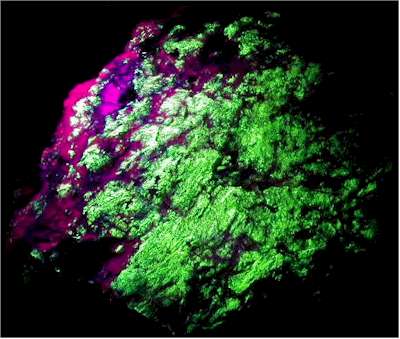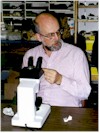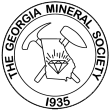Fluorescence
and Other Color Changes in Minerals:
Glowing Rocks, Mineral Chameleons, and Colorless Amethyst
by
Julian Gray, P.G.

(hyalite opal from Chalk Mountain, North Carolina)
Did you know that there is a difference between a motor and an engine? A motor is the type of electrical device that runs your vacuum cleaner, the table saw in your wood shop, or propels kids’ toys. They require an external electric power supply from a power cord or from a battery. An engine, on the other hand, develops its own energy from some internal fuel supply such as gasoline, as with your car or lawnmower engines. If they didn’t, you’d need a long extension cord for your car. Yes it is true that automotive mechanics and racecar drivers talk about car motors, but the really should say engine. Calling the thing that powers your car a motor is as silly (and incorrect) as calling the thing that powers your table saw an engine. We put gas in our engines and we plug in our motors.
Now that we have that straight, we can easily understand fluorescent and phosphorescent minerals. Minerals are composed of atoms, which in turn contain electrons at specific energy levels. Ultraviolet light is an energy source. When we shine an ultraviolet lamp on a mineral that fluoresces, the atoms that make up the mineral absorb energy from the light by moving electrons to higher energy levels. However, the electrons cannot remain in this unstable, excited state. When the energized electrons return to the original lower energy level, they give back the difference in energy by emitting visible light. This is what causes the mineral to produce light. As long as the ultraviolet lamp energy source is on, electrons are continually jumping from lower to higher energy levels and back, in the process producing the wonderful fluorescent colors that we see. If the mineral only produces light when ultraviolet light is shining on the mineral, this is called fluorescence (Robbins, 1994). In this case, the mineral does not glow. Repeat after me, “Minerals fluoresce, they do not glow.” That is like calling the thing in your car a motor. Using the engine/motor analogy, let’s think of fluorescence as the motor – it only runs when we put energy into the mineral by shining the UV light on it.
Now wait a minute though – some minerals can give off light even after we remove the ultraviolet light. How is that possible? If we expose some minerals to ultraviolet light the electrons in the atoms become excited and producing fluorescent light as they change energy levels. But if the electrons remain in an excited state after the ultraviolet light is removed, the mineral will continue to give off light until all the electrons are back in their original unexcited (called ground) state. Scientists call this phosphorescence and in this case the mineral does glow (Robbins, 1994). The mineral stores energy and gives it back even after the simulation is removed. This is like the engine in our analogy – it runs without an external power supply.
OK, ready for a real test? There is a variety of sodalite called hackmanite. It is found in the Kola Peninsula of Russia, in south Greenland, in Canada, and in Afghanistan, just to name some of the better known locations. Most hackmanite is yellow. Hackmanite fluoresces, but after fluorescing it will have a different color (purple) when you turn on the white room light. After a few minutes with the lights back on, the purple color fades and the hackmanite returns to its original yellow color (Robbins, 1994). What is going on here? To explain this I first need to add that in white room lights or in sunlight an atom in a mineral may produce a certain color that depends on different, but fixed arrangements of electrons (Nassau, 1983). To explain changing colors, the car engine analogy won’t work here so we’ll have to turn to basketball. Think of the electrons as basketballs. If the ball is lying on the basketball court, this is like having one arrangement of electrons and the mineral will have one color. We pick up the basketball and throw it through the hoop, this is like energizing the electrons with the ultraviolet light. After going through the hoop the ball falls back to the court floor similar to the electron falling back to a lower energy level and the mineral emits light of some color – it fluoresces. Hackmanite fluoresces, but many electrons get stuck in a new, high-energy position in atoms and this is what causes the mineral to have a different color when the lights are turned on. In our basketball analogy, imagine what would happen if we tied the bottom of the basketball net together. We could throw the ball through the hoop, but it would get stuck in the basket. If ultraviolet light causes electrons to get stuck at the higher energy level, then a new mineral color is produced. But when we turn the room lights on, the new color fades. White light also energizes electrons, just not as much as ultraviolet light. The white light has enough energy to unstick the electrons from their new home. It is the equivalent of beating on the bottom of the basket with net tied together. When the basketball/electron is in the basket/higher position in the atom, the mineral has one color. When the basketball/electron is on the court/lower position, the mineral has a different color (Nassau, 1978). When the basketball/electron is falling it fluoresces. This whole color change phenomenon is called tenebrescence or photochroism (Robbins, 1994).
Had enough? Aw, come on just one more. Quartz in its normal state is colorless. A combination of a chemical impurity and a tiny amount of radiation will cause quartz to become purple or light brown. We call these varieties of quartz amethyst and smoky quartz, respectively. In the case of amethyst the impurity in the quartz is iron. In smoky quartz the impurity is aluminum. What actually causes the quartz to change from colorless to purple or from colorless to smoky is a rearranging of electrons in the mineral’s structure (Nassau, 1978 and Nassau, 1983). Sound familiar? That’s right. This is like the basketball/electron getting stuck in a different position. So why don’t amethyst and smoky quartz fade back to colorless quartz even in sunlight? In the case of quartz, white light is not powerful enough to knock the basketball/electron out of its hole. We only used ultraviolet light to change the color of hackmanite, Mother Nature used radioactivity to change quartz to amethyst or smoky quartz. It’s like the basketball net is very deep.
So is it possible to change amethyst and smoky quartz to colorless quartz? Sure. The color can be removed by heating the mineral. That provides sufficient energy to knock the electrons back to their original positions. So go find some beautiful amethyst jewelry and put it in the oven on the cleaning cycle. At the end of the cycle, that annoying purple color will be gone. I actually intend to try this experiment with a cheap amethyst someday. Not to worry, we can restore the color by simply placing the quartz in a gamma radiation source, like a nuclear reactor. This process of removing the color is called bleaching; it removes the color (stain) in the mineral (Nassau, 1978). Of course no one actually wants to remove the color from amethyst or smoky quartz. And don’t worry, the radiation that produced the color only disrupted the electrons, it did not leave the mineral radioactive. And besides, the radiation source in the host rock has decayed to safe levels by the time we collect the mineral anyway.
And finally, in a few cases, heating a mineral will actually enhance its color. This is the case with the tanzanite variety of zoisite. Many of the finished faceted stones that you see on the market have been heat-treated. And now you can guess why this happens!
Last questions:
(1) Do the members of the Fluorescent Mineral Society actually fluoresce?
(2) Since we change color when we are exposed to ultraviolet rays of the Sun are we tenebrescent?
References:
- Nassau, Kurt, 1983, The physics and chemistry of color; the fifteen causes of color:
John Wiley & Sons, inc., New York, 454 p. - Nassau, K., 1978, The origins of color in minerals:
American Mineralogist, vol. 63 no. 3-4, p. 219-229. - Robbins, M., 1994, Fluorescence: Gems and Minerals under Ultraviolet Light:
Geoscience Press, Inc., Phoenix, Arizona, 374 p.

Copyright © Georgia Mineral Society, Inc.
